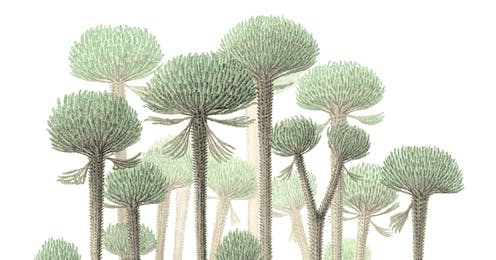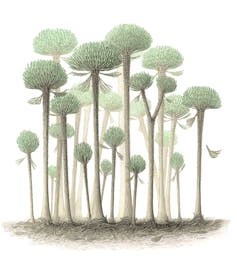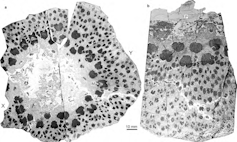
Imagine a world without trees, and then try to think about the changes that would need to happen for these trees to evolve from the small primitive plants that came before them. I spend as much time as I can trying to find evidence for this transition, which is currently estimated to have happened between 390-380m years ago, in the Mid-Devonian Epoch.
One plant type, the extinct cladoxylopsids – an ancient plant group now only found as fossils – has continually demanded my attention. Despite these fossils first being found in the 1850s, understanding of the plants was highly confused for decades. This is a common problem in the study of fossil plants, because the living plants fall apart when they die, and it is often hard to determine which parts of which fossils should be joined back together. But during the 2000s we had major successes in reconstructing Devonian cladoxylopsids, culminating in a series of extraordinary discoveries of complete or almost complete fossil trees in Scotland, Gilboa, New York and Germany.
The picture that emerged of the earliest types of cladoxylopsid – by then recognised to be the first forms of tree to appear – was of a long tapering trunk, up to at least eight metres high, with distinctive short branches attached around the top to form a crown. From a distance, the trees would have looked like palms, with bases up to a metre in diameter. There were no leaves as such, just branched twig-like appendages which presumably had a photosynthetic function in the carbon dioxide rich atmosphere of those times.

The first trees
Most trees today have a solid trunk, which gets bigger through the formation of a new ring of woody tissues – made up of xylem cells – under the bark each year.
In cladoxylopsids, however, the xylem grew in a ring of individual parallel strands around the outside of the trunk. Inside this zone, more xylem strands formed a complex network with many interconnections both to each other and to the outer parallel strands. The majority of the inside of the trunk was completely hollow.
This unusual structure is confusing, and raises questions about how ancient trees managed to grow so big. The outer parallel strands could easily allow for the trunk diameter to expand just by moving apart from each other, and the space between filled with soft tissues known as parenchyma.
But the inner network of xylem strands is a different matter. Trying to expand the diameter of this network would be catastrophic. Not only would the wood resist the change of shape, but as the outside diameter widened, the inside of the tree would be pulled inwards and downwards relative to the outside, and the whole plant would collapse.
Volcanic fossil
Understanding how cladoxylopsids managed to grow so big was going to need an extraordinary fossil – which arrived on my desk in late 2012 as a small trunk preserved in silica from volcanic eruptions in north-west China. The glassy silica had filled the plant cells, but not destroyed the cell walls, so we could study every cell present in the plant on the day it died. Even more incredibly, in 2015 another perfectly preserved trunk more than 70cm in diameter was found by my Chinese colleagues.
What we learnt from these fossils was amazing. Each of the many hundreds of xylem strands in the tree had its own growth rings, adding woody tissue around the outside on a regular basis. The cross section looks like a ring of little trees all growing in unison. However the soft parenchyma tissue between the xylem strands was the most informative. Rather than being crushed by the growth of the wood in the stem, the tissue seemed to be proliferating on a prodigious scale. This provided the power to push the strands apart and expand the trunk diameter.

As a last trick, the shape of these normally round cells could be used to detect the strain put upon them. We found that the interconnections of the woody xylem strands were being slowly ripped apart as the tree grew. But at the same time the damage was being repaired, which kept the plant functioning and structurally sound as the woody skeleton accommodated the growth. Overall we determined that the bottom of the trunk slowly collapsed outward to form the large flat-bottomed tree bases characteristic of this type of plant.
No tree does anything as complicated today. Several types of plants, notably palms, grow a little by diffuse expansion of the soft parenchyma tissues, but this does not appear to have dramatic consequences for the xylem skeleton.
Cladoxylopsid growth has to go down in history as the most complex way to become a tree. Maybe the lack of competition from other tree types at the beginning was what allowed this to occur. We know that simpler forms of cladoxylopsids lived towards the end of the Devonian period, and that shortly after they became extinct. Perhaps they were outcompeted by other types of plants with simpler growth strategies, or plants with seeds, or they could not cope with the low carbon dioxide world they helped create.
Whatever the reason for their extinction, this new finding of how they grew will help us understand how cladoxylopsids shaped our early terrestrial environments and how they interacted with the atmosphere.
Chris Berry receives funding from NERC (Natural Environment Research Council) UK and National Geographic.
This article was originally published on The Conversation. Read the original article.







